Medical Electronics Market Size
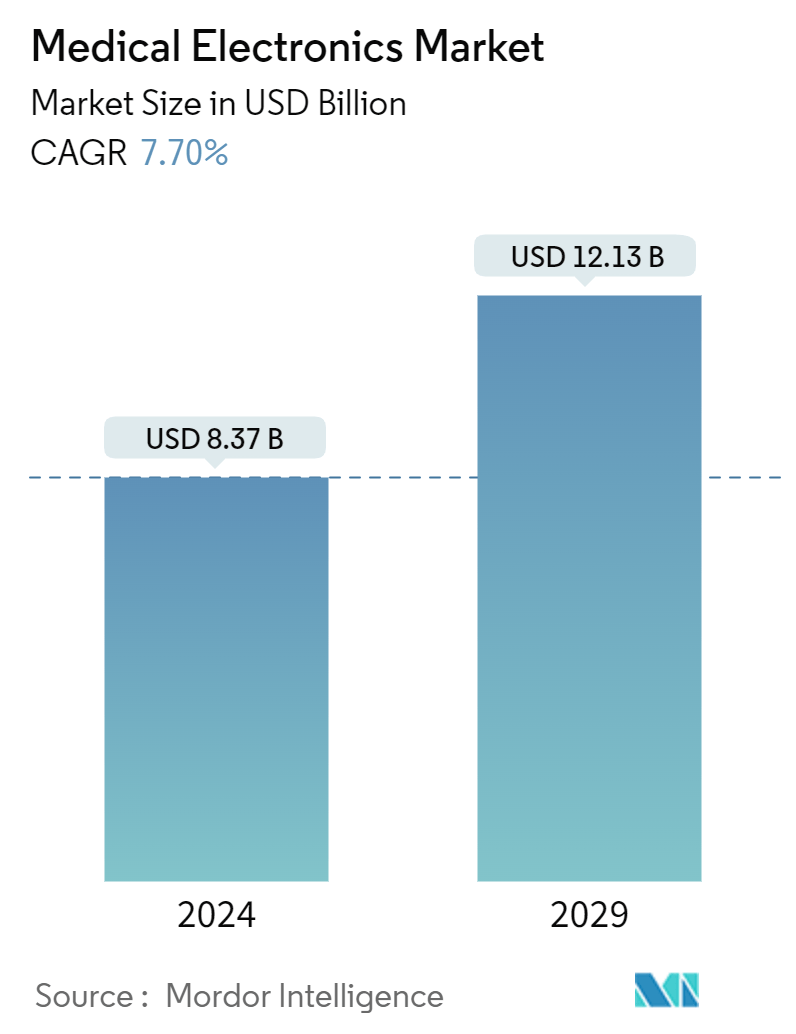
| Study Period | 2019 - 2029 |
| Market Size (2024) | USD 8.37 Billion |
| Market Size (2029) | USD 12.13 Billion |
| CAGR (2024 - 2029) | 7.70 % |
| Fastest Growing Market | Asia Pacific |
| Largest Market | North America |
Major Players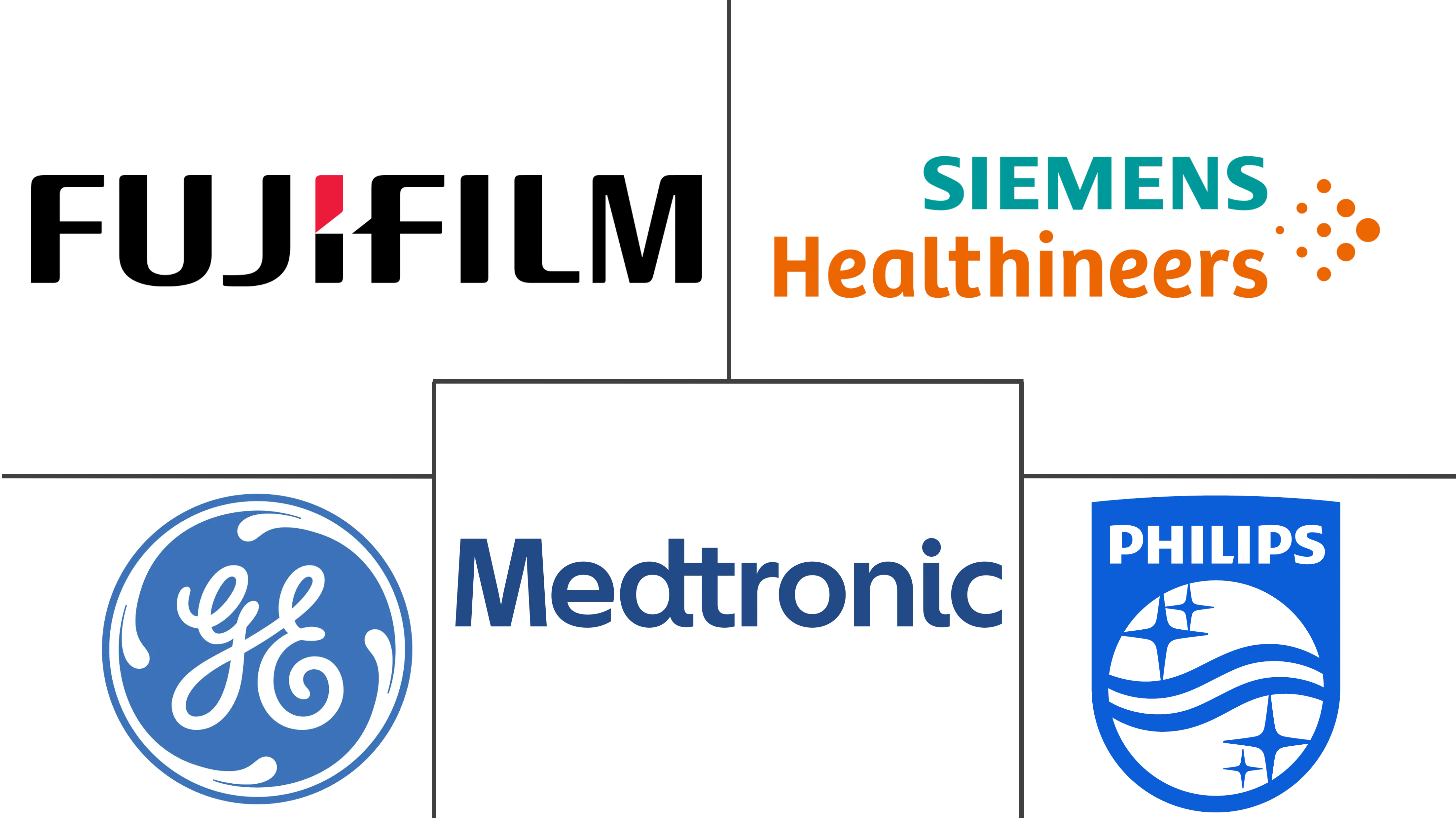
*Disclaimer: Major Players sorted in no particular order |
Medical Electronics Market Analysis
The Medical Electronics Market size is estimated at USD 8.37 billion in 2024, and is expected to reach USD 12.13 billion by 2029, growing at a CAGR of 7.70% during the forecast period (2024-2029).
COVID-19 impacted the medical electronics market initially. The decrease in imaging volumes during the pandemic affected the growth pace of the market in the preliminary phase. For instance, an article published in the Journal of the American College of Radiology in July 2021, reported that the total imaging volume in 2020 (weeks 1-16) declined by 12.29% as compared to the previous year. It also reported that post-COVID-19 (weeks 10-16) revealed a greater decrease (28.10%) in imaging volumes across all patient service locations. The same source also reported that an 88% decline was seen at week 16 in outpatient imaging, and MRI contributed to a nearly 74% decline. Such a decline in volumes due to the pandemic has impacted market growth amid the outbreak. However, the demand for patient monitoring devices greatly increased during the pandemic period as they allowed contactless communication and tracking of medical conditions by clinicians. Moreover, the application of x-ray imaging for the diagnosis and treatment of COVID-19 and associated diseases has positively impacted the market's growth in the latter phase of the pandemic. For instance, from an article published in BMC Pulmonary Medicine Journal, in June 2021, it has been observed that a chest x-ray was used to diagnose and follow up patients with COVID-19 pneumonia. Thus, with the relaxed restrictions, resumed diagnosis and treatment services, and the high adoption of medical imaging equipment, the demand for medical electronics has increased in the post-pandemic phase, and as per the analysis, the market is expected to regain its full potential in the next two to three years.
The factors such as the rising incidence and prevalence of chronic diseases coupled with the increasing geriatric population and the growing application of imaging devices.
The increasing burden of chronic diseases such as cancer, neurological diseases, cardiovascular diseases, respiratory diseases, and others are the key factor driving the market growth. For instance, according to the 2022 statistics published by the IDF, about 537 million adults aged between 20-79 were living with diabetes globally, and this number is projected to increase to 643 million and 783 million by 2030 and 2045, respectively. Thus, the higher number of diabetic and obese people increases the risk of developing other chronic diseases such as coronary artery disease, hypertension, and stroke, which increases the need for early detection as well as regular monitoring of the heart condition. This is anticipated to fuel market growth over the forecast period.
Additionally, as per data published in the Alzheimer's Association 2022 report, more than 1.5 million people in Germany were suffering from Alzheimer's disease, and this number is expected to double by 2050. This is anticipated to increase the need to early detect the brain abnormalities associated with mild cognitive impairment as well as understand the neuropathological mechanisms. This is further expected to fuel the demand for MRI and CET scan testing, thereby bolstering the market growth.
Aging results from accumulating a wide variety of molecular and cellular damage over time, leading to a gradual decrease in physical and mental capacity and a growing risk of disease. Common conditions in older age include back and neck pain and osteoarthritis, chronic obstructive pulmonary diseases, heart diseases, cancer, and others. For instance, according to the March 2022 update of the Australian Bureau of Statistics, the prevalence of heart disease in Australia was 4.0% in 2020-2021, which equates to about 1 million people. Also, as per the same source, in Australia, heart disease increased with age, from 2.3% of people aged 45-54 years through to 23.2% of people aged 75 years and over, with males being the most affected by it in the country. Since the older population is prone to the disease, it is expected to generate the need for medical electronics for diagnosis, thereby driving the market's growth.
Furthermore, rising product launches and approvals are also expected to increase market growth over the forecast period. For instance, in March 2022, Rapid Response Revival launched CellAED, one of the first personal, portable defibrillators that use sophisticated technology designed to improve the chances of surviving a sudden cardiac arrest, in the United Kingdom.
Moreover, the increasing government funding, as well as rising company activities for developing advanced products, are also contributing to the market growth. For instance, in July 2021, a new magnetic resonance imaging (MRI) scanner facility opened in Leicester, worth EUR 3.1 billion (USD 3.28 billion). This new facility increases the current imaging capacity of researchers from 500 cardiovascular research participants a year to 1,500. The new scanner facility has been funded by a EUR 1 million (USD 1.1 million) grant from the BHF. It will be jointly owned by Leicester's Hospitals, which has dedicated EUR 2.1 million (USD 2.2 million) to the facility, and the University of Leicester.
Therefore, owing to the aforementioned factors, the studied market is expected to grow over the forecast period. However, the strict regulations for device approval and the high cost of maintenance of the devices are expected to hinder the growth of the medical electronics market over the forecast period.
Medical Electronics Market Trends
MRI Segment Expected to Hold Significant Market Share in the Medical Electronics Market Over the Forecast Period
The magnetic resonance imaging (MRI) segment is expected to witness significant growth in the medical electronics market over the forecast period owing to factors such as the introduction of advanced MRI systems and the rising adoption of MRI systems in emerging markets. Most of the emerging economies are densely populated countries with developing healthcare infrastructures, and the adoption of MRI systems in these regions is expected to increase over the years due to the high burden of diseases such as cancer, musculoskeletal and neurological disorders, and others, coupled with the growth in the aging population.
The growing development of technologically advanced systems and their increasing adoption and product launches increase the availability of these systems in the market and are expected to increase the market segment growth over the forecast period. For instance, in February 2021, Insightec received market approval from the Brazilian HRA, ANVISA, for its Exablate 4000 (Exablate Neuro) platform, which uses MR-guided focused ultrasound to precisely ablate tissue deep within the brain without incisions and will enable treatment for essential tremor and tremor-dominant Parkinson's disease. Similarly, in October 2021, Esaote launched a total body magnetic resonance imaging system called Magnifico Open, which is an open MRI system with cutting-edge technology to satisfy not only clinical needs but also address operational and financial demands.
Furthermore, the rising company's focus on adopting various key strategies, such as expansion, collaborations, and others, is also contributing to the market segment's growth. For instance, in November 2021, a sophisticated MRI facility was launched at the NBRC in Haryana, India. Also, in July 2021, a new magnetic resonance imaging (MRI) scanner facility opened in Leicester for EUR 3.1 billion (USD 3.28 billion), which will increase the current imaging capacity of researchers from 500 cardiovascular research participants a year to 1500. The new scanner facility has been funded by a EUR 1 million (USD 1 million) grant from the BHF.
Therefore, owing to the aforementioned factors, such as the rising number of product launches and increasing company activities, the studied segment is expected to grow over the forecast period.
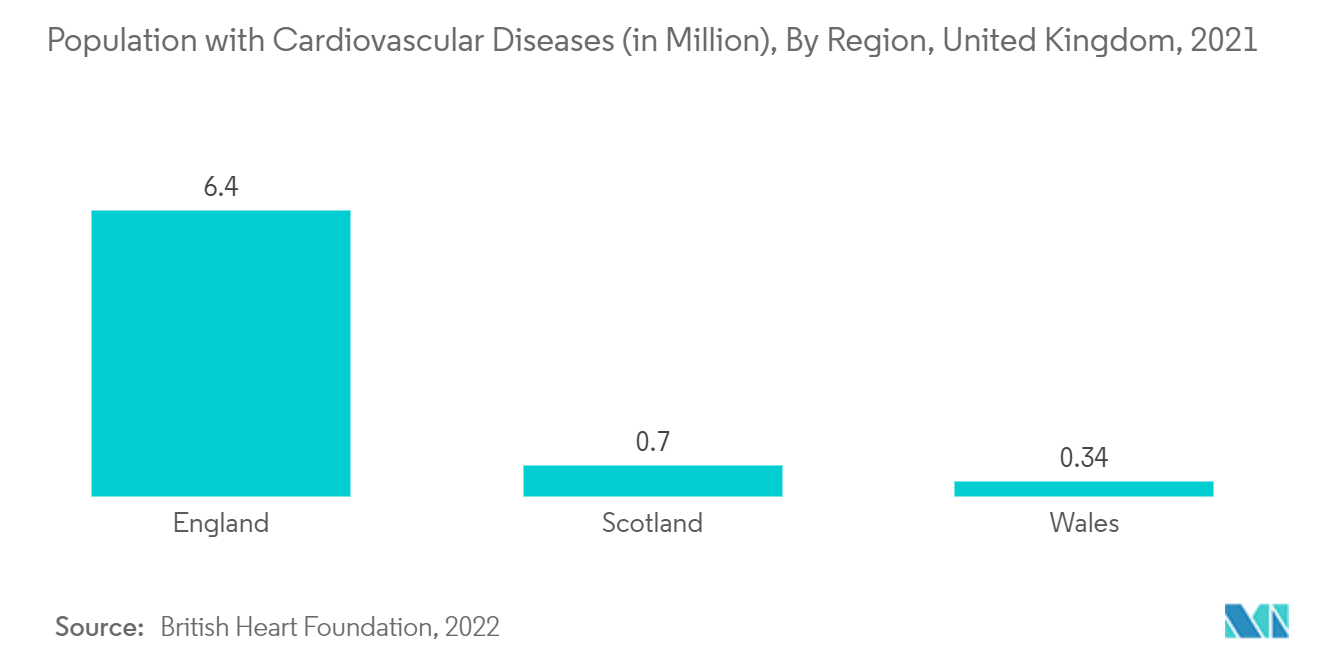
North America is Expected to Have the Significant Market Share Over the Forecast Period
North America is expected to dominate the market over the forecast period owing to factors such as the rising burden of chronic diseases among the population, the increasing use of advanced technology in healthcare systems, the presence of a well-established healthcare infrastructure, and high healthcare spending. In addition, the growing demand for minimally invasive therapies and rising technological advancements in medical electronics are also expected to increase market growth over the forecast period.
The increasing prevalence and burden of chronic diseases is the key factor driving the demand for medical electronics in the region. For instance, as per the data published by the CDC, in April 2022, an estimated 35 million adults in the United States were expected to suffer from arthritis by 2040. This is expected to increase the demand for medical electronics that provide detailed images of the joint and surrounding tissues that aid in the early detection of the condition, hence boosting the market growth. Also, as per the 2022 statistics published by the ACS, over 1.9 million new cancer cases and 11,030 new cancer cases are expected to be diagnosed in the United States and New Mexico, respectively, in 2022. Also, as per 2022 statistics published by the Canadian Cancer Society, about 233,900 new cancer cases are expected to be diagnosed in Canada in 2022. With the growing burden of cancer cases, the demand for medical electronics such as MRIs, CT scans, and others is increasing, which helps in the early detection of tumors in the body. This is anticipated to fuel market growth over the forecast period.
Furthermore, the rising company activities in developing products and increasing product launches are also contributing to market growth. For instance, in February 2022, the FDA approved Esaote's Magnifico Open MRI, a new open whole-body MRI system in the United States. Also, in July 2021, the USFDA approved Medtronic's two AccuRhythm artificial intelligence (AI) algorithms for use with the LINQ II insertable cardiac monitor (ICM).
Therefore, owing to factors such as the high burden of arthritis and cancer among the population as well as growing company activities in the region, the studied market is anticipated to grow over the forecast period.
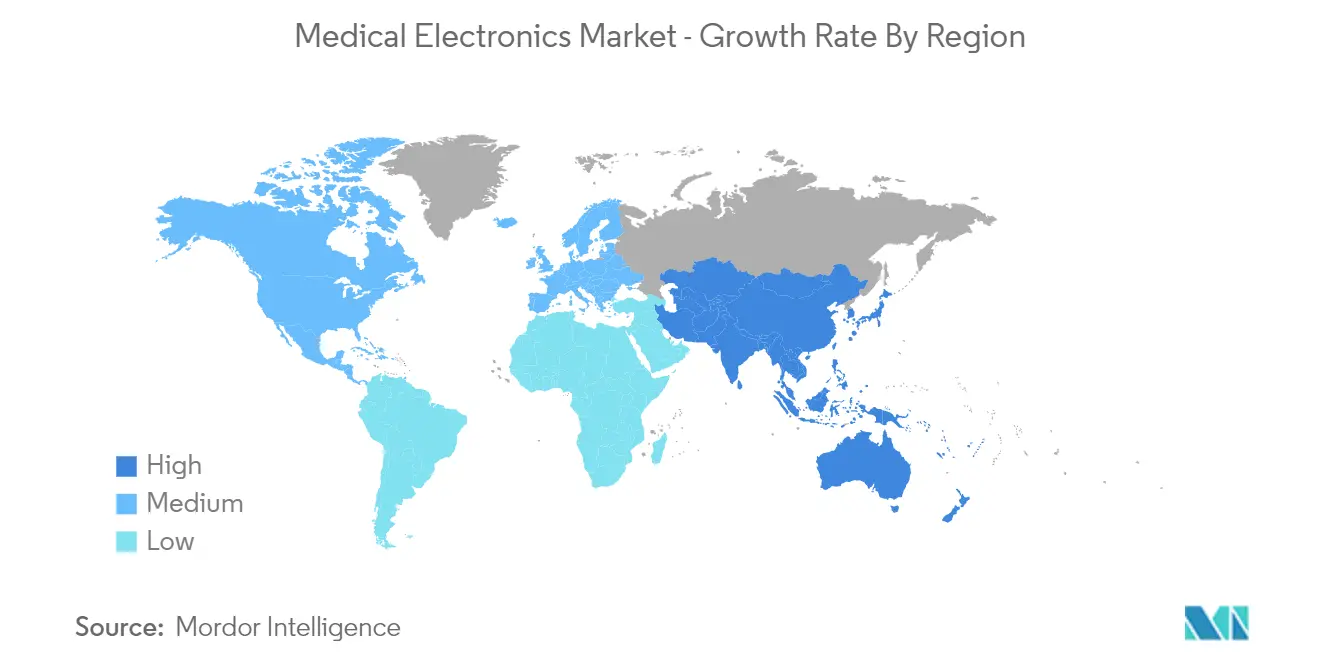
Medical Electronics Industry Overview
The medical electronics market is competitive with the presence of a large number of several major players. In terms of market share, a few of the major players are currently dominating the market. Some prominent players are vigorously making acquisitions and joint ventures with other companies to consolidate their market positions across the world. Some companies currently dominating the market include Medtronics PLC, GE Healthcare, Koninklijke Philips NV, Siemens Healthcare GmbH, and Fujifilm Corporation.
Medical Electronics Market Leaders
-
Koninklijke Philips N.V.
-
Siemens Healthcare GmbH
-
Fujifilm Corporation
-
Medtronic PLC
-
GE Healthcare
*Disclaimer: Major Players sorted in no particular order
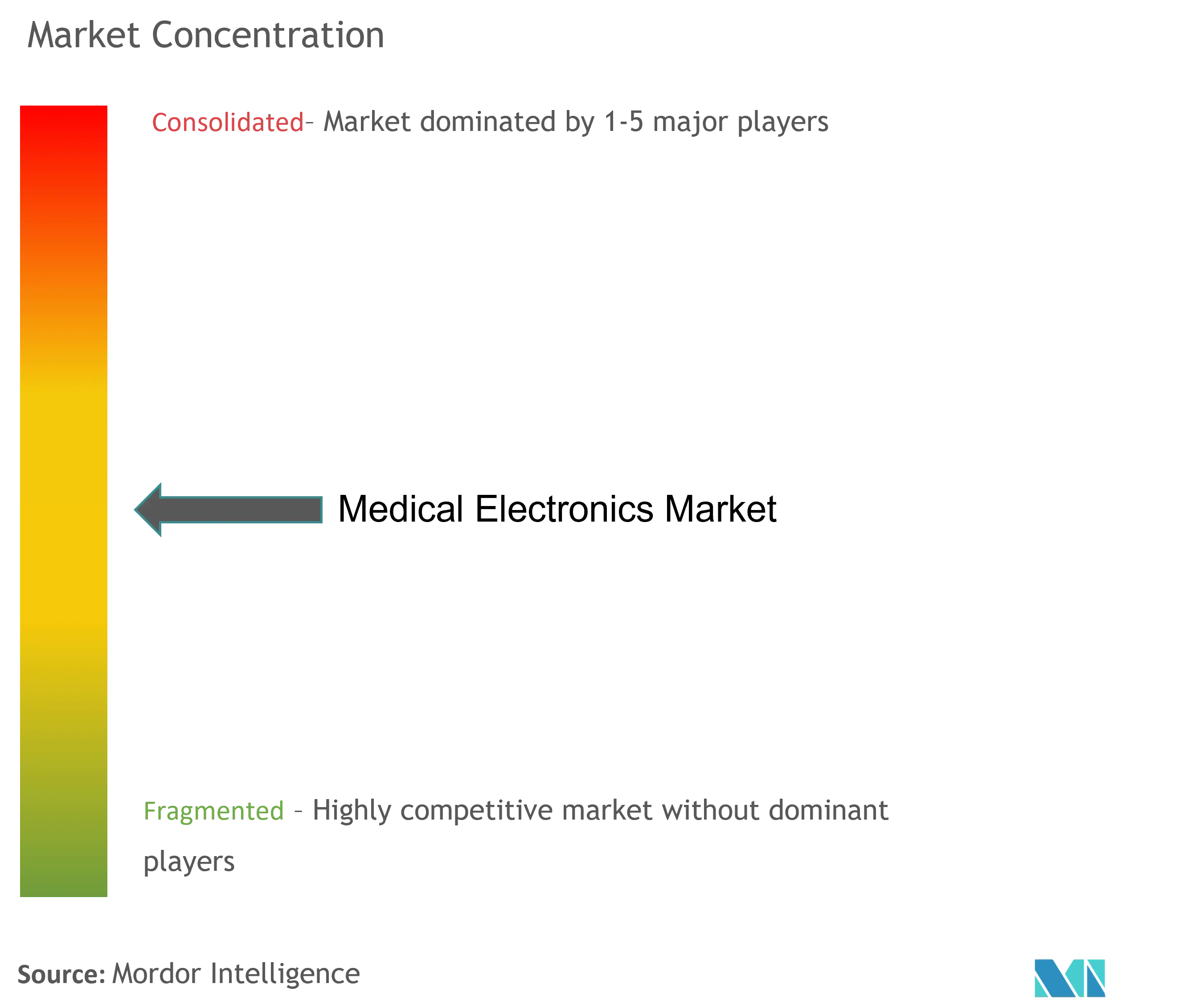
Medical Electronics Market News
- In August 2022, the South Korean Ministry of Food and Drug Safety granted clearance to VUNO, a medical artificial intelligence company, for its ECG device, Hativ Pro, a portable medical device that measures a user's heart rate and sends this data through a connected mobile phone app.
- In February 2022, Shineco, Inc. entered a partnership with Weifang Jianyi Medical Devices Co., Ltd., one of the leading Chinese medical device companies based in Shandong Province, to jointly manufacture and sell imaging devices, including PET, PET-CT, and PET-MRI.
Medical Electronics Market Report - Table of Contents
1. INTRODUCTION
- 1.1 Study Assumptions and Market Definition
- 1.2 Scope of the Study
2. RESEARCH METHODOLOGY
3. EXECUTIVE SUMMARY
4. MARKET DYNAMICS
- 4.1 Market Overview
-
4.2 Market Drivers
- 4.2.1 Increasing Geriatric Population
- 4.2.2 Rising Application of Imaging Devices
-
4.3 Market Restraints
- 4.3.1 Ramped up regulatory scrutiny
- 4.3.2 High Cost and Maintenance
-
4.4 Porter's Five Forces Analysis
- 4.4.1 Threat of New Entrants
- 4.4.2 Bargaining Power of Buyers/Consumers
- 4.4.3 Bargaining Power of Suppliers
- 4.4.4 Threat of Substitute Products
- 4.4.5 Intensity of Competitive Rivalry
5. MARKET SEGMENTATION (Market Size by Value - USD million)
-
5.1 By Product
- 5.1.1 Non-invasive Products
- 5.1.1.1 MRI
- 5.1.1.2 X-Ray
- 5.1.1.3 CT Scan
- 5.1.1.4 Ultrasound
- 5.1.1.5 Nuclear Imaging Systems
- 5.1.1.6 Cardiac Monitors
- 5.1.1.7 Respiratory Monitors
- 5.1.1.8 Hemodynamic Monitors
- 5.1.1.9 Multipara Monitors
- 5.1.1.10 Digital Thermometers
- 5.1.1.11 Other Products
- 5.1.2 Invasive Products
- 5.1.2.1 Endoscopes
- 5.1.2.2 Pacemakers
- 5.1.2.3 Implantable Cardioverter Defibrillator (ICD)
- 5.1.2.4 Implantable Loop Recorders
- 5.1.2.5 Spinal Cord Stimulator
- 5.1.2.6 Other Invasive Products
-
5.2 By Application
- 5.2.1 Diagnostics
- 5.2.2 Monitoring
- 5.2.3 Therapeutics
-
5.3 By End User
- 5.3.1 Hospitals and Clinics
- 5.3.2 Ambulatory Surgical Centers
- 5.3.3 Other End Users
-
5.4 Geography
- 5.4.1 North America
- 5.4.1.1 United States
- 5.4.1.2 Canada
- 5.4.1.3 Mexico
- 5.4.2 Europe
- 5.4.2.1 Germany
- 5.4.2.2 United Kingdom
- 5.4.2.3 France
- 5.4.2.4 Italy
- 5.4.2.5 Spain
- 5.4.2.6 Rest of Europe
- 5.4.3 Asia-Pacific
- 5.4.3.1 China
- 5.4.3.2 Japan
- 5.4.3.3 India
- 5.4.3.4 Australia
- 5.4.3.5 South Korea
- 5.4.3.6 Rest of Asia-Pacific
- 5.4.4 Middle-East and Africa
- 5.4.4.1 GCC
- 5.4.4.2 South Africa
- 5.4.4.3 Rest of Middle-East and Africa
- 5.4.5 South America
- 5.4.5.1 Brazil
- 5.4.5.2 Argentina
- 5.4.5.3 Rest of South America
6. COMPETITIVE LANDSCAPE
-
6.1 Company Profiles
- 6.1.1 Medtronic PLC
- 6.1.2 GE Healthcare
- 6.1.3 Koninklijke Philips NV
- 6.1.4 Siemens Healthcare GmbH
- 6.1.5 Fujifilm Corporation
- 6.1.6 McKesson Corporation
- 6.1.7 Olympus Corporation
- 6.1.8 Hologic Inc.
- 6.1.9 Drägerwerk AG & Co. KGaA
- 6.1.10 Getinge Inc.
- 6.1.11 Esaote SpA
- 6.1.12 Canon Medical Systems
- 6.1.13 Mindray Medical International Limited
- *List Not Exhaustive
7. MARKET OPPORTUNITIES AND FUTURE TRENDS
** Subject To AvailablityMedical Electronics Industry Segmentation
As per the scope of the report, medical electronics is an electronics division that deals with the design, installation, and use of electrical appliances and equipment for medical applications such as study, monitoring, treatment, diagnosis, assistance, and care. The market is segmented by Product (Non-Invasive Products (MRI, X-Ray, CT Scan, Ultrasound, Nuclear Imaging Systems, Cardiac Monitors, Respiratory Monitors, Hemodynamic Monitors, Multipara Monitors, Digital Thermometers, and Other Products) and Invasive Products (Endoscopes, Pacemakers, Implantable Cardioverter Defibrillator (ICD), Implantable Loop Recorders, Spinal Cord Stimulator and Other Invasive Products), Application (Diagnostics, Monitoring, and Therapeutics), End User (Hospitals and Clinics, Ambulatory Surgical Centers, and Other End Users), and Geography (North America, Europe, Asia-Pacific, Middle-East and Africa, and South America). The market report also covers the estimated market sizes and trends for 17 countries across major regions globally. The report offers the value (in USD million) for the above segments.
| By Product | Non-invasive Products | MRI |
| X-Ray | ||
| CT Scan | ||
| Ultrasound | ||
| Nuclear Imaging Systems | ||
| Cardiac Monitors | ||
| Respiratory Monitors | ||
| Hemodynamic Monitors | ||
| Multipara Monitors | ||
| Digital Thermometers | ||
| Other Products | ||
| By Product | Invasive Products | Endoscopes |
| Pacemakers | ||
| Implantable Cardioverter Defibrillator (ICD) | ||
| Implantable Loop Recorders | ||
| Spinal Cord Stimulator | ||
| Other Invasive Products | ||
| By Application | Diagnostics | |
| Monitoring | ||
| Therapeutics | ||
| By End User | Hospitals and Clinics | |
| Ambulatory Surgical Centers | ||
| Other End Users | ||
| Geography | North America | United States |
| Canada | ||
| Mexico | ||
| Geography | Europe | Germany |
| United Kingdom | ||
| France | ||
| Italy | ||
| Spain | ||
| Rest of Europe | ||
| Geography | Asia-Pacific | China |
| Japan | ||
| India | ||
| Australia | ||
| South Korea | ||
| Rest of Asia-Pacific | ||
| Geography | Middle-East and Africa | GCC |
| South Africa | ||
| Rest of Middle-East and Africa | ||
| Geography | South America | Brazil |
| Argentina | ||
| Rest of South America |
Medical Electronics Market Research FAQs
How big is the Medical Electronics Market?
The Medical Electronics Market size is expected to reach USD 8.37 billion in 2024 and grow at a CAGR of 7.70% to reach USD 12.13 billion by 2029.
What is the current Medical Electronics Market size?
In 2024, the Medical Electronics Market size is expected to reach USD 8.37 billion.
Who are the key players in Medical Electronics Market?
Koninklijke Philips N.V., Siemens Healthcare GmbH, Fujifilm Corporation, Medtronic PLC and GE Healthcare are the major companies operating in the Medical Electronics Market.
Which is the fastest growing region in Medical Electronics Market?
Asia Pacific is estimated to grow at the highest CAGR over the forecast period (2024-2029).
Which region has the biggest share in Medical Electronics Market?
In 2024, the North America accounts for the largest market share in Medical Electronics Market.
What years does this Medical Electronics Market cover, and what was the market size in 2023?
In 2023, the Medical Electronics Market size was estimated at USD 7.73 billion. The report covers the Medical Electronics Market historical market size for years: 2019, 2020, 2021, 2022 and 2023. The report also forecasts the Medical Electronics Market size for years: 2024, 2025, 2026, 2027, 2028 and 2029.
Medical Electronics Industry Report
The global medical electronics market is segmented by product, application, end user, and geography. The market includes non-invasive and invasive products, used in diagnostics, monitoring, and therapeutics. End users encompass hospitals and clinics, ambulatory surgical centers, and other end users across North America, Europe, Asia-Pacific, Middle East and Africa, and South America.
This industry report provides a comprehensive industry overview, highlighting the market size and market growth. The market forecast outlook to 2029, along with historical data, offers valuable insights into market trends and market predictions. The industry analysis includes key market leaders and the market segmentation by various parameters.
Industry research and industry information are crucial for understanding the industry outlook and industry trends. The report includes industry statistics, industry sales, and industry size, which are essential for market data and market value assessment. Additionally, the report provides a market review and market outlook, helping stakeholders make informed decisions.
The market report includes a detailed report example and is available as a free report PDF download. Research companies can benefit from this report, which includes market analysis and market segmentation details. The report also covers the market growth rate and market forecast, providing a thorough market overview. Industry reports and industry research are vital for staying updated with the latest industry trends and market data.



